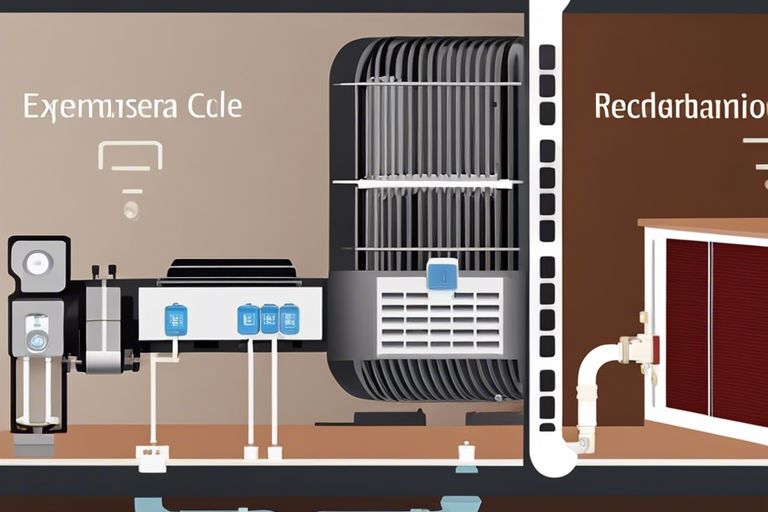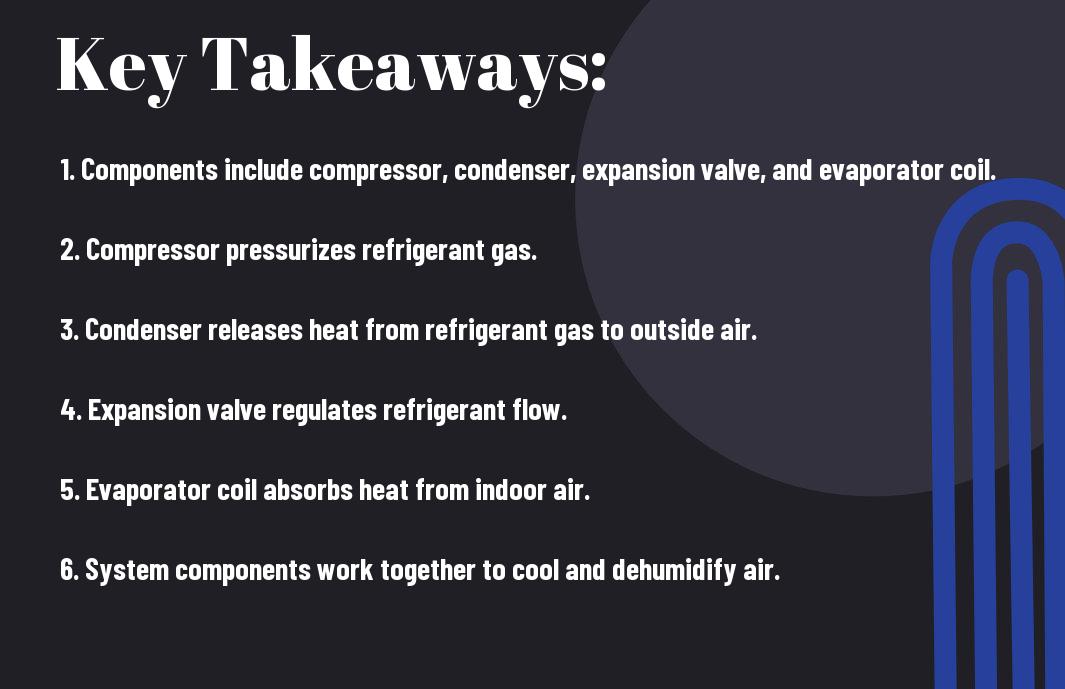Greetings! Today, I want to delve into the intricate components of an air conditioning system. Understanding the various parts that make up your AC system is crucial for ensuring its proper function and maintenance. Whether you’re a homeowner or a renter, having a grasp of how your AC system works can help you identify potential issues and save you from costly repairs. If you’re curious to learn more about the inner workings of your air conditioner, I highly recommend checking out my previous blog post on What are the Components of an Air-Conditioner?
Key Takeaways:
- Understanding the Basic Components: An AC system consists of several main components, including a compressor, condenser, evaporator, expansion valve, and refrigerant.
- The Role of the Compressor: The compressor is responsible for pressurizing the refrigerant and circulating it through the system to remove heat from the indoor air.
- Importance of the Condenser: The condenser works to release the heat from the refrigerant to the outside air, allowing the refrigerant to cool and return to a liquid state.
- Function of the Evaporator: The evaporator absorbs heat from the indoor air and cools it down before the cooled air is circulated back into the living space.
- Understanding the Role of the Expansion Valve: The expansion valve regulates the flow of the refrigerant into the evaporator, controlling the temperature and pressure of the system.
Understanding Air Conditioning
The air conditioning (AC) system in your home or car is a complex system that works to regulate the temperature and humidity of the air. Understanding how your AC system works can help you better maintain it and troubleshoot any issues that may arise.
The Refrigeration Cycle
The refrigeration cycle is the heart of any air conditioning system. It is a continuous process that allows the AC to cool the air effectively. The cycle begins when the refrigerant, a special chemical, enters the compressor as a low-pressure gas. The compressor then squeezes the gas, increasing its temperature and pressure before sending it to the condenser. There, the refrigerant releases heat and becomes a high-pressure liquid, which then flows to the evaporator.
The Role of the Compressor
The compressor plays a crucial role in the AC system by compressing the refrigerant, raising its temperature and pressure. This process allows the refrigerant to release heat, helping to cool the air. Without a properly functioning compressor, your air conditioning system would not be able to effectively cool your home or car.
The Function of the Condenser
The condenser is responsible for releasing the heat absorbed by the refrigerant in the evaporator. It is usually located in front of the car’s radiator or outside of your home, allowing the released heat to dissipate into the surrounding air. A properly functioning condenser is essential for maintaining the efficiency of your AC system.
The Importance of the Evaporator
The evaporator is where the refrigerant absorbs heat from the air inside your car or home, cooling it down in the process. This cooled air is then blown into the living space, bringing relief from the heat. A functioning evaporator is essential for ensuring your AC system works properly, effectively cooling the air in your home or car.
Key Components of an AC System
Assuming you are new to the world of air conditioning, it is important to understand the key components that make up an AC system. This knowledge will help you to better maintain and troubleshoot your system, as well as make informed decisions when it comes to repairs and upgrades. The main components of an AC system include air filters, thermostat and control systems, ductwork and ventilation, as well as insulation and sealing.
Air Filters and Purification
When it comes to the quality of the air you breathe, air filters and purification play a crucial role in an AC system. Air filters are designed to trap dust, dirt, pollen, and other airborne particles, preventing them from circulating in your home. They also help to improve indoor air quality and protect the system from damage caused by debris. Some AC systems also include air purification systems that can remove odors, allergens, and even microorganisms from the air, providing a healthier and more comfortable environment for you and your family.
Thermostat and Control Systems
The thermostat and control systems are the brains of an AC system, allowing you to set and regulate the temperature in your home. With a programmable thermostat, you can schedule temperature changes according to your daily routine, saving energy and reducing your utility bills. Advanced control systems also offer features such as zoning, which allows you to create different temperature zones in your home, and remote access, so you can adjust the settings from anywhere using your smartphone or computer.
Ductwork and Ventilation
The ductwork and ventilation are responsible for distributing the conditioned air throughout your home. Properly designed and maintained ductwork ensures efficient airflow and balanced temperature distribution in every room. In addition, good ventilation is essential for fresh air intake and proper indoor air circulation. Poorly sealed or insulated ducts can result in energy loss, uneven cooling, and higher utility costs, so it is important to have them inspected and maintained regularly.
Insulation and Sealing
Insulation and sealing are essential for maintaining a comfortable indoor environment and maximizing the efficiency of your AC system. Proper insulation helps to keep the conditioned air inside your home, preventing heat gain in the summer and heat loss in the winter. Additionally, sealing air leaks and gaps in your home’s envelope can reduce energy waste and improve overall comfort. By investing in insulation and sealing upgrades, you can significantly lower your energy bills and reduce your carbon footprint.
Maintenance and Troubleshooting
For the smooth and efficient operation of your AC system, regular maintenance is essential. It not only helps in maximizing the system’s lifespan but also ensures optimal performance. Additionally, proper maintenance can help in preventing costly repairs down the road. In this section, I will discuss some important maintenance tips and common AC problems along with their solutions to help you keep your system in top condition.
Regular Maintenance Tips
Keeping up with regular maintenance is crucial for the overall performance and longevity of your AC system. To ensure your system operates at its best, here are some key maintenance tips to follow:
- Change your air filter regularly, ideally every 1-3 months, to maintain proper airflow and indoor air quality.
- Inspect and clean the outdoor unit to remove any debris, leaves, and dirt that may hinder airflow.
- Schedule an annual professional maintenance check-up to tune up your system and address any potential issues.
- Check and clean the evaporator and condenser coils to improve energy efficiency and prevent system breakdown.
The regular maintenance of your AC system not only helps in improving its efficiency but also prevents any major breakdowns. The last thing you want is for your AC to fail during the height of summer. By following these maintenance tips, you can ensure smooth operation and lower the risk of unexpected issues.
Common AC Problems and Solutions
Despite regular maintenance, AC systems can develop common problems that need to be addressed promptly. If you notice any of the following issues, it is important to take action:
It could be a refrigerant leak, which requires professional attention. Another common problem is a malfunctioning thermostat, which can often be resolved by replacing the batteries or recalibrating the settings. Clogged air filters can also lead to reduced airflow and efficiency, but this can be easily remedied by replacing the filter. Moreover, a malfunctioning compressor can result in inadequate cooling, and it may need to be repaired or replaced by a qualified technician.
Understanding these common AC problems and their solutions can help you address issues as they arise, ensuring optimal comfort and efficiency in your home.


Components of an AC System – Understanding Air Conditioning
Presently, we have covered the main components of an AC system, from the compressor and condenser to the evaporator and expansion valve. Understanding how these parts work together to cool and circulate air in your home is key to maintaining a comfortable indoor environment. For a more detailed breakdown of the main parts of your AC system, you can refer to Main Parts of Your AC System. By grasping the fundamentals of air conditioning, you can effectively troubleshoot any issues that may arise and communicate effectively with HVAC professionals.
FAQ
Q: What are the main components of an AC system?
A: The main components of an AC system include the compressor, condenser, evaporator, expansion valve, and refrigerant. These components work together to cool and circulate air in a building or vehicle.
Q: How does the compressor function in an AC system?
A: The compressor is responsible for pressurizing the refrigerant, turning it into a high-pressure, high-temperature gas. This gas is then sent to the condenser to release heat and become a liquid again.
Q: What is the role of the condenser in an AC system?
A: The condenser is where the hot, high-pressure refrigerant gas is condensed into a liquid, releasing heat in the process. This liquid refrigerant is then sent to the expansion valve to be expanded and cooled.
Q: How does the evaporator work in an AC system?
A: The evaporator is responsible for absorbing heat from the air inside a building or vehicle. As the liquid refrigerant passes through the evaporator coils, it evaporates into a gas, absorbing heat and cooling the air in the process.
Q: What is the function of the expansion valve in an AC system?
A: The expansion valve regulates the flow of the refrigerant into the evaporator, allowing the liquid refrigerant to expand and cool significantly. This controls the temperature and pressure of the refrigerant as it enters the evaporator, contributing to the overall cooling process.









Leave a comment